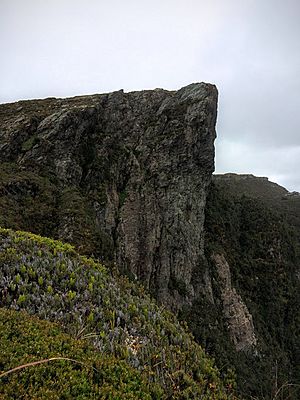Dwarf coral fern facts for kids
Quick facts for kids Dwarf coral fern |
|
|---|---|
 |
|
| Gleichenia abscida growing amongst alpine scrub north of Federation peak | |
| Scientific classification | |
| Genus: |
Gleichenia
|
| Species: |
abscida
|
The dwarf coral fern (Gleichenia abscida) is a special and rare fern. It grows in the mountains of southwestern Tasmania, an island state of Australia. This unique plant was first described by Leonard Rodway, who was a dentist and a botanist (someone who studies plants).
What makes the dwarf coral fern stand out from other ferns in its family, Gleichenia, is its frond. A frond is like a leaf of a fern. Most Gleichenia ferns have fronds that branch out many times. But the dwarf coral fern's frond is much simpler. It only has two main parts, or blades. The tip where these two blades meet does not have special cells that make it grow longer. This means its frond stops growing at that point.
What Does It Look Like?
The dwarf coral fern has many stems, called stipes. There can be between 25 and 40 of these stems. Each stem is usually 9 to 46 centimeters (about 3.5 to 18 inches) long. The fronds, or fern leaves, can grow up to 65 centimeters (about 25 inches) long.
These stems grow from long, underground stems called rhizomes. These rhizomes are like roots but are actually stems that spread out. They are about 2.5 to 3.5 millimeters (about 0.1 to 0.14 inches) thick.
The fern has small, rounded leaf parts called pinnules. These pinnules are only 1 to 2 millimeters (about 0.04 to 0.08 inches) wide. The top side of these small leaf parts is flat. The bottom side curves strongly inward, forming a small pocket.
How It Reproduces
Inside these small pockets on the pinnules, the fern holds its spores. Spores are like tiny seeds that ferns use to reproduce. These pockets are called sori (SOH-rye). Each sorus usually contains 2 to 4 tiny sacs called sporangia (spor-AN-jee-uh). These sporangia are where the spores are made and stored. When the spores are ready, they are released to grow into new ferns.

